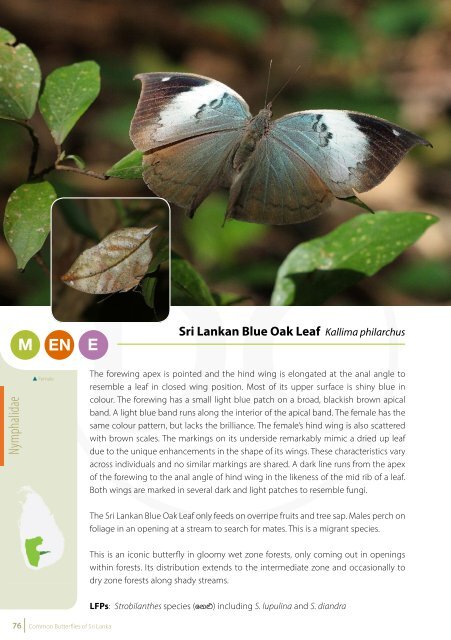Common Butterflies of Sri Lanka
Common Butterflies of Sri Lanka
Common Butterflies of Sri Lanka
You also want an ePaper? Increase the reach of your titles
YUMPU automatically turns print PDFs into web optimized ePapers that Google loves.
M<br />
EN<br />
E<br />
<strong>Sri</strong> <strong>Lanka</strong>n Blue Oak Leaf Kallima philarchus<br />
<strong>Common</strong> Sailor Neptis hylas<br />
S<br />
LC<br />
Nymphalidae<br />
Female<br />
The forewing apex is pointed and the hind wing is elongated at the anal angle to<br />
resemble a leaf in closed wing position. Most <strong>of</strong> its upper surface is shiny blue in<br />
colour. The forewing has a small light blue patch on a broad, blackish brown apical<br />
band. A light blue band runs along the interior <strong>of</strong> the apical band. The female has the<br />
same colour pattern, but lacks the brilliance. The female’s hind wing is also scattered<br />
with brown scales. The markings on its underside remarkably mimic a dried up leaf<br />
due to the unique enhancements in the shape <strong>of</strong> its wings. These characteristics vary<br />
across individuals and no similar markings are shared. A dark line runs from the apex<br />
<strong>of</strong> the forewing to the anal angle <strong>of</strong> hind wing in the likeness <strong>of</strong> the mid rib <strong>of</strong> a leaf.<br />
Both wings are marked in several dark and light patches to resemble fungi.<br />
The <strong>Sri</strong> <strong>Lanka</strong>n Blue Oak Leaf only feeds on overripe fruits and tree sap. Males perch on<br />
foliage in an opening at a stream to search for mates. This is a migrant species.<br />
The sexes look similar but the female is quite large. The upper side is blackish brown.<br />
A white streak commencing from the base <strong>of</strong> the forewing is followed by two white<br />
spots which form a band. A basal line on the hind wing together with patches on the<br />
forewing form a second parallel band. Rectangular patches on the hind wing make up<br />
a third parallel band. The marginal and sub-marginal white bands are fairly indistinct.<br />
The background <strong>of</strong> its underside is golden brown, with the white patches seen on the<br />
upper surface visible with additional faint lines in between. The scale-less dorsal area<br />
<strong>of</strong> its thorax has a greenish sheen.<br />
It has a characteristic sailing flight and is active during most <strong>of</strong> the day except early<br />
morning and late afternoon. It eludes the heat by resting in closed wing position<br />
during the hot hours <strong>of</strong> the day, for otherwise it is found with open wings. It feeds on<br />
both flowers and fruits.<br />
Nymphalidae<br />
This is an iconic butterfly in gloomy wet zone forests, only coming out in openings<br />
within forests. Its distribution extends to the intermediate zone and occasionally to<br />
dry zone forests along shady streams.<br />
LFPs: Strobilanthes species (fk¿) including S. lupulina and S. diandra<br />
It prefers sunny habitats such as parks, roadside vegetation, wastelands and scrublands.<br />
LFPs: This butterfly has the most number <strong>of</strong> LFPs in <strong>Sri</strong> <strong>Lanka</strong> which are not even<br />
restricted to certain families <strong>of</strong> plants. It uses 30 plant species in 7 families. It includes<br />
Dalbergia pseudo-sissoo (nUr je,a), Trema orientalis (.evqU) and Urena lobata (wem,)<br />
76 <strong>Common</strong> <strong>Butterflies</strong> <strong>of</strong> <strong>Sri</strong> <strong>Lanka</strong><br />
<strong>Common</strong> <strong>Butterflies</strong> <strong>of</strong> <strong>Sri</strong> <strong>Lanka</strong> 77















